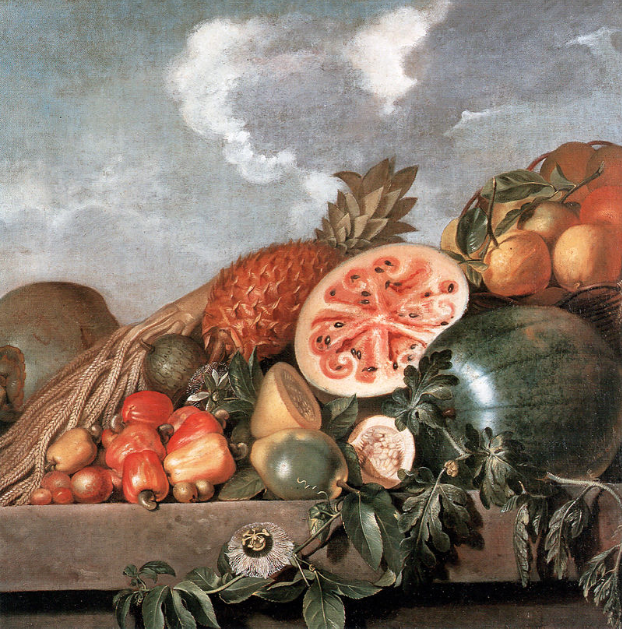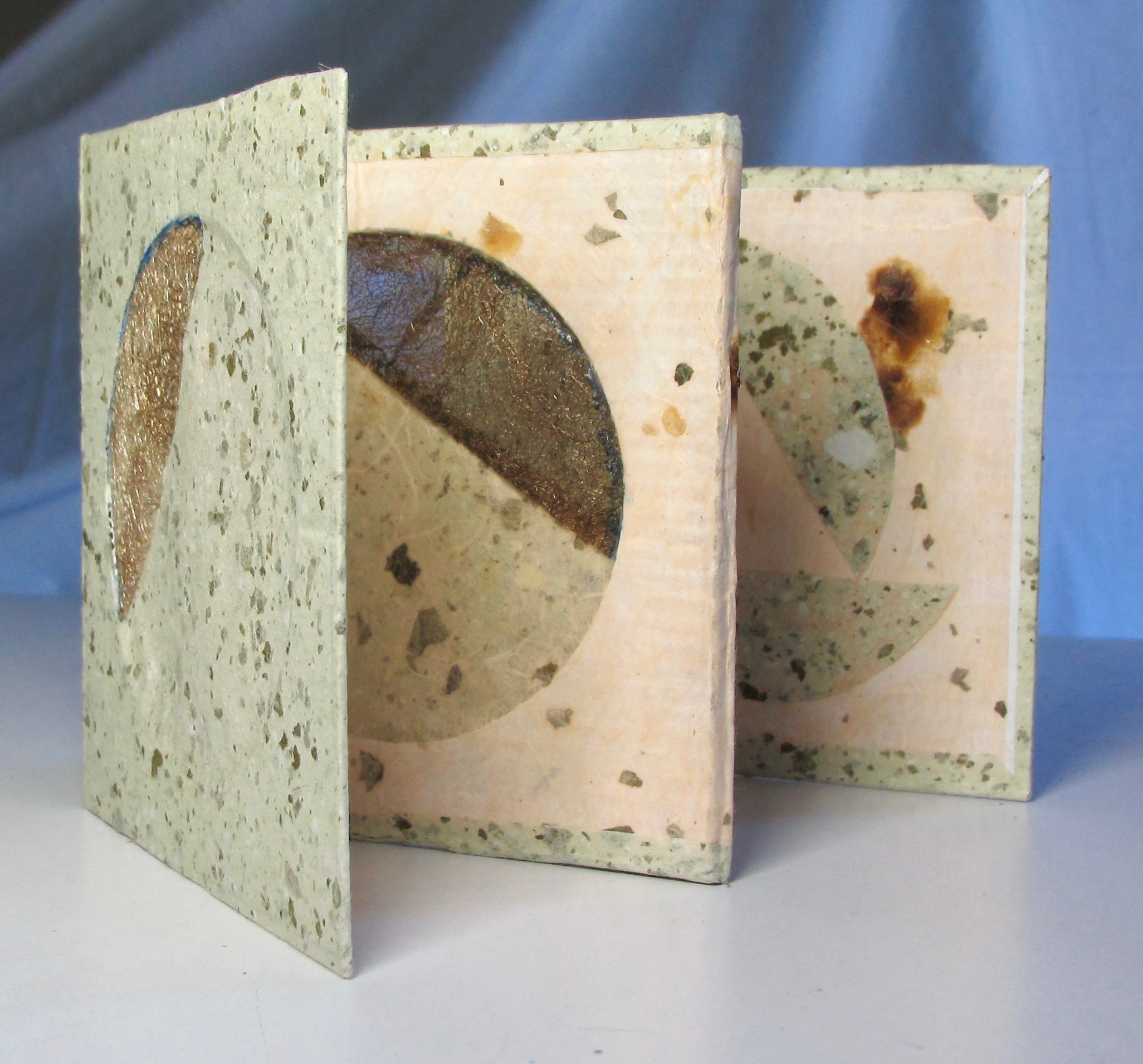Take out one hundred candles and light them for the 100th birthday of artist Lucia Vernarelli. It’s the darkest time of the year in the Northern Hemisphere and Lucia was named for light when she was born on December 13, 1920.
Read MoreFiltering by Tag: women artists
Grape Leaves of Salt Lake City
A friend brought me a gift of grape leaves after visiting her daughter and future son-in-law in Salt Lake City. This accordion book forms a bridge between receiving that gift of fresh and vibrant grape leaves and my desire to perpetuate, materialize, and share that experience of beauty with others.
It began with a perception of beauty in the leaves, apparent to my eyes, a moment that lingered in my mind even as the leaves grew limp and withered. I wanted to share that insight with others and move it from the realm of my inner thoughts into physical, three-dimensional form.
The materials of paper, cardboard, ink, paint, and the leaves themselves, form a bridge that seeks to access that beauty even after it has faded from the physical realm. It brings the viewer both backward to the original gift and forward to a new moment of apprehension. My friend’s gift of grape leaves, carried eastward from Salt Lake City to the island of Manhattan, inspired and generated this gift; it created a bridge of time, of relationship, and of enduring beauty.
This work is now on view at Our Savior’s Atonement Lutheran Church, 178 Bennett Avenue, in Washington Heights, NYC as part of their “building Bridges” art show.
Art for National Watermelon Day
August 3rd is National Watermelon Day and I've chosen a few art works, including one of my own, to mark this unofficial food holiday.
Still Life with Watermelon, Pineapple and other Fruits, oil on canvas, Albert Eckhout, Dutch painter active in 17th century Brazil
Hoosick Street The Summer Kitchen, colored pencils, strawberry sepal, acrylic interference paint
Ellen Halloran, American artist, 2018
Still Life with Watermelon, Pears, and Grapes oil on canvas, Lily Martin Spencer, American artist, 1860
Compassion and the Artist
The Winter 2018 issue of The Compassion Anthology contains my essay on compassion and the artist. This essay is my answer to the question "Do artists show compassion to themselves when they create works of art?"
Compassion and the Artist
Ellen Halloran
Compassion is defined as a sympathetic consciousness of others’ distress and sorrow accompanied by a desire to relieve that suffering. It can refer to both the understanding of another’s pain and the action that stems from that feeling.
Does an artist offer compassion to herself/himself in the process of creating a work of art?
How does an artist’s work begin? We have an idea that appears in our mind, something with a life of its own that wants to be realized in the material world. We may have a feeling of apprehension. Can we fully and worthily realize this idea that wants to come forth? Avoidance brings us to a state of intellectual paralysis, to a sense of being locked inside of ourselves as the idea searches for a material existence. Some artists speak of being “blocked,” of feeling depressed. Other artists experience this as a kind of anxiety.
Movement unlocks our feeling of helplessness. We move from an idea to a finished form by simple actions—picking up a pencil, making a mark, tearing a sheet of paper, executing a brushstroke, joining surfaces together—until what was once only a thought achieves a palpable existence in the material world.
Flannery O’Connor wrote that in art the self, (the artist) becomes “self-forgetful” to facilitate the demands of the ideas that we see in our minds and the things that we actually create from those ideas. In this self-forgetfulness artists act compassionately toward themselves by keeping their ideas in motion, alleviating their own anxieties, and bringing them forward as gifts to the world in lyrical, energetic and beautiful forms.
Ellen Halloran is a visual artist working in several media. She has worked as a metalsmith, jeweler, legal proofreader, art teacher and art therapist. She developed and implemented art programs for child victims of sexual abuse, children who witnessed violence, and children recovering from traumatic events. Her work has been seen in galleries and is in many private collections.
RE-Formation: Moon and Moths
I think of "reformation" as change, transformation, a state of transition and even as metamorphosis.
Materials themselves provide me with ideas. The fabrics of this work inspired me as I changed disposable cardboard packaging, something that is usually tossed without a glance or hesitation, into an object to be considered with joy and wonder. I covered it with handmade papers that contain fragments of leaves and plant fibers. The pre-cut circles in the cardboard seemed like windows through which the constantly changing moon can be seen. I thought of moths seeking light at the time of the new moon and I remembered that a friend had given me some pieces of moth cocoon, traces of a very real metamorphosis.
All of the materials here have gone through changes, have been re-formed. Trees and plants and insects have been changed into a small book that I have named "RE-Formation:Moon and Moths."
Our Saviour's Atonement Church in Washington Heights , NYC is sponsoring a Reformation-themed show opening on Saturday, October 14, 2017.
A Summertime Feast for the Eyes
Giovanna Garzoni was a successful artist of the early 17th century. This is her 'Chinese Porcelain Bowl with Cherries.'
Rosa Bonheur
Rosa Bonheur was born on March 16, 1822. Her parents were followers of a movement that favored the education of girls alongside boys. Rosa's father was a painter and her mother taught piano. Rosa was taught to paint by her father and by the age of 14 she was making copies of paintings in the Louvre; this was a traditional way of study for artists over the centuries. Before setting out on her path as an artist and sculptor she copied the works of many artists she admired including Nicolas Poussin and Peter Paul Rubens.
Today Rosa Bonheur is regarded as an 'animalière,' an artist whose primary vision is the representation of animal forms in paintings and sculpture. Critics of her work complain that she did nothing to expand the boundaries of art; essayists seem more interested in her non-conformist clothing than in her painting.
I see in her work a a traditional and sensitive understanding of the intertwined lives of animals and humans; she represented animals as she saw them in the surrounding countryside. her work is skillfully executed and approaches an understanding of the animals themselves. Her representation of beauty lives on in the twenty-first century.
"Noonday Rest" by Rosa Bonheur
Still Life with Watermelon, Pears, and Grapes
This painting by Lilly Martin Spencer is in the collection of the National Museum of Women in the Arts in Washington, D.C. It is oil on canvas and is assumed to have been painted around the year 1860. I love the balance of rich colors, the detail of texture given to the surface on which the fruit rests, and the top of the watermelon which appears to have been bitten in enjoyment.
I need to make a correction to my post of February 15th. It's true that Lilly was painting right up until the time of her death, at her easel, but she died in New York City, not in Highland, New York. She is buried next to her husband, Benjamin Rush Spencer, in Highland.
Nearly every day of the year is a national food holiday here in the United States. August 3 is National Watermelon Day. Foods from apples to popcorn to zucchini all have their own commemorative day - sometimes a whole month will be dedicated to a particular food. For some reason that I don't understand, National Watermelon Day is celebrated in August but July is National Watermelon Month.
Still Life with Watermelon, Pears, and Grapes by Lilly Martin Spencer (circa 1860)
The Artist and Her Family on a Fourth of July Picnic
This painting by Lilly Martin Spencer can be seen at the National Museum of Women in the Arts in Washington, D.C. It was painted around the year 1864 and depicts a scene of relaxation, frivolity, and enjoyment as friends and family gather to celebrate Independence Day.
At the center of the picture is the artist's husband, Benjamin. Apparently his weight has been too much for the tree swing and he lies on the ground. The artist depicts herself with arms outstretched going to his aid. A child is trying to help him.
There are at least two people in this painting who appear to be African-American. While one of them is dispensing a refreshment of some sort, the other appears to be enjoying the day's festivitivies. The painting is oil on canvas and measures 49 1/2" x 63."
Lilly Martin Spencer
Lilly Martin Spencer (1822 - 1902) was born in England to French parents. The family immigrated to New York in 1830. Lilly began painting at an early age and was encouraged to do so by her parents who recognized her abilities. She spent many years living and working in Ohio. In her marriage she was the main breadwinner and her work achieved national recognition. She and her husband raised seven children and she was painting right up until her death in 1902 in Highland, New York.
Still Life with Berries and Currants (!859 - 1860)











